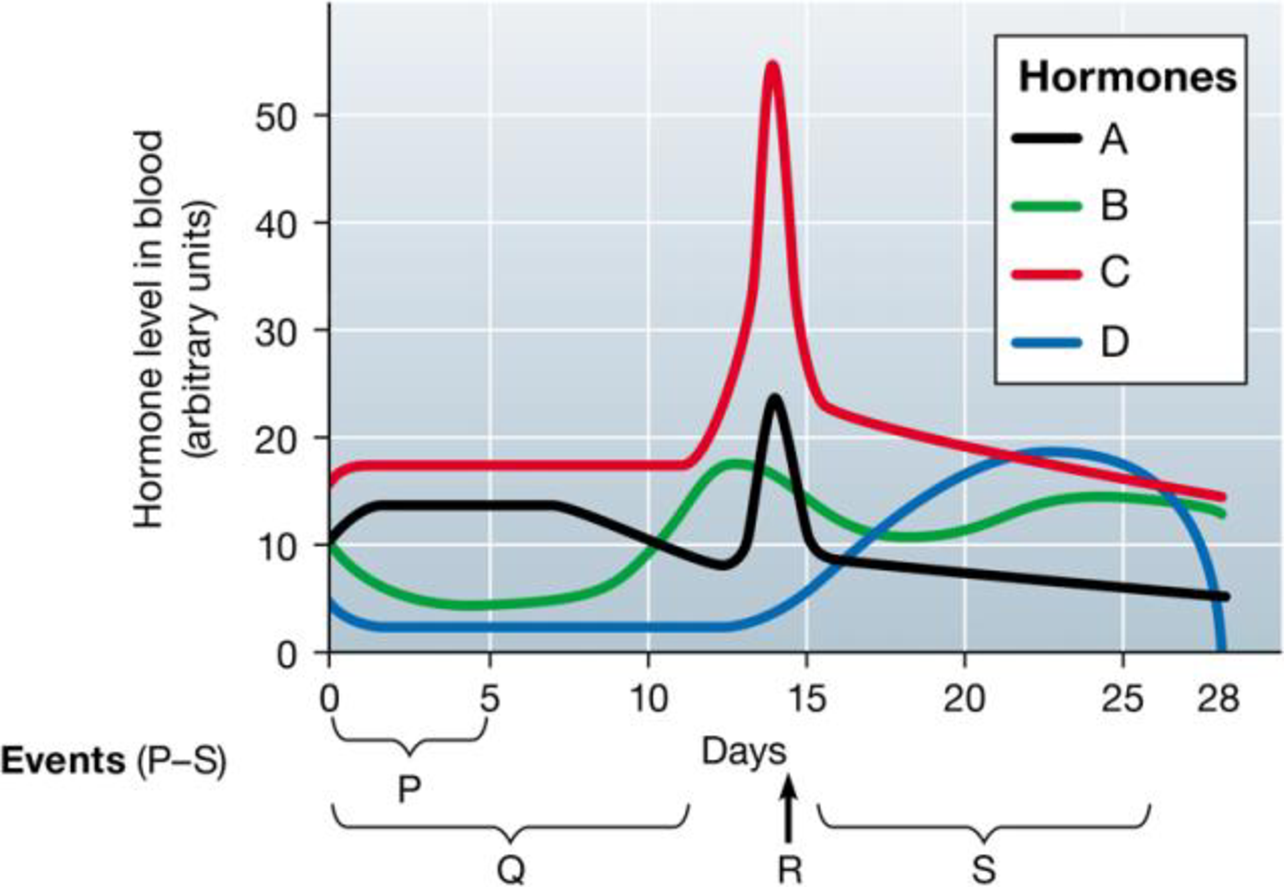
This graph plots the rise and fall of pituitary and ovarian hormones during the human ovarian cycle. Identify each hormone (A–D) and the reproductive events with which each one is associated (P–S). For A–D, choose from estrogen, LH, FSH, and progesterone. For P–S, choose from ovulation, growth of follicle, menstruation, and development of corpus luteum. How would the right-hand side of this graph be altered if pregnancy occurred? What other hormone is responsible for triggering this change?

To identify: The hormones A-D, the reproductive events with which each hormone is related, the way in which the right hand side of the graph will be altered if pregnancy occurs and the hormones that are responsible for triggering this change.
Introduction:
Menstrual cycle is a cycle that takes place in females. It is a cycle or a series of events in which there are hormonal changes in females in ovary and in the uterine wall. In this cycle there is formation of a mature egg in the ovary of females which due to hormonal influence undergoes a series of changes and if the fertilization of the egg takes place then there is formation of zygote and henceforth there is formation of a neonate.
Explanation of Solution
This graph is about the various phases of the menstrual cycle and the hormones related to them. In a menstrual cycle there are three phases. Here in the graph the first phase that is P shows menstruation or the menstrual phase which occurs from first to fifth day, the hormone related to this phase is labeled as A which is FSH. It is secreted by the anterior lobe of the pituitary gland.
Second phase is the follicular phase which is marked as Q. It starts from the first day and continues till 13th day, the hormone that is related to this phase is labeled as B which is estrogen. It is secreted by the granulose cells of ovarian follicle and by corpus luteum.
The third phase is the ovarian phase which is marked as R. It occurs at the fourteenth day, the hormone that is related to this phase is labeled as C which is LH. This hormone is secreted by the anterior lobe of pituitary gland.
And the last phase is the development of corpus luteum, which is marked as S. It occurs after the fifteenth day. The hormone that is related to it is progesterone which is marked as D. it is secreted by the corpus luteum which is the ruptured covering of the matured egg upon stimulation by the FSH hormone after ovulation.
Before pregnancy the cycle as mentioned in the diagram goes uninterrupted but after pregnancy with the secretion of the human chorionic gonadotropin hormone which is secreted by the placenta, the entire hormonal cycle changes.
With the secretion of human chorionic gonadotropin hormone, with the onset of pregnancy the estrogen and the progesterone levels remain high and the other hormones levels becomes low.
The menstrual cycle in females is responsible for the production and the discharge of the egg formed by the ovaries in females.
Want to see more full solutions like this?
Chapter 27 Solutions
Campbell Biology: Concepts & Connections (9th Edition)
- Describe the principle of homeostasis.arrow_forwardExplain how the hormones of the glands listed below travel around the body to target organs and tissues : Pituitary gland Hypothalamus Thyroid Parathyroid Adrenal Pineal Pancreas(islets of langerhans) Gonads (testes and ovaries) Placentaarrow_forwardWhat are the functions of the hormones produced in the glands listed below: Pituitary gland Hypothalamus Thyroid Parathyroid Adrenal Pineal Pancreas(islets of langerhans) Gonads (testes and ovaries) Placentaarrow_forward
- Describe the hormones produced in the glands listed below: Pituitary gland Hypothalamus Thyroid Parathyroid Adrenal Pineal Pancreas(islets of langerhans) Gonads (testes and ovaries) Placentaarrow_forwardPlease help me calculate drug dosage from the following information: Patient weight: 35 pounds, so 15.9 kilograms (got this by dividing 35 pounds by 2.2 kilograms) Drug dose: 0.05mg/kg Drug concentration: 2mg/mLarrow_forwardA 25-year-old woman presents to the emergency department with a 2-day history of fever, chills, severe headache, and confusion. She recently returned from a trip to sub-Saharan Africa, where she did not take malaria prophylaxis. On examination, she is febrile (39.8°C/103.6°F) and hypotensive. Laboratory studies reveal hemoglobin of 8.0 g/dL, platelet count of 50,000/μL, and evidence of hemoglobinuria. A peripheral blood smear shows ring forms and banana-shaped gametocytes. Which of the following Plasmodium species is most likely responsible for her severe symptoms? A. Plasmodium vivax B. Plasmodium ovale C. Plasmodium malariae D. Plasmodium falciparumarrow_forward
- please fill in missing parts , thank youarrow_forwardplease draw in the answers, thank youarrow_forwarda. On this first grid, assume that the DNA and RNA templates are read left to right. DNA DNA mRNA codon tRNA anticodon polypeptide _strand strand C с A T G A U G C A TRP b. Now do this AGAIN assuming that the DNA and RNA templates are read right to left. DNA DNA strand strand C mRNA codon tRNA anticodon polypeptide 0 A T G A U G с A TRParrow_forward
 Biology 2eBiologyISBN:9781947172517Author:Matthew Douglas, Jung Choi, Mary Ann ClarkPublisher:OpenStax
Biology 2eBiologyISBN:9781947172517Author:Matthew Douglas, Jung Choi, Mary Ann ClarkPublisher:OpenStax Human Physiology: From Cells to Systems (MindTap ...BiologyISBN:9781285866932Author:Lauralee SherwoodPublisher:Cengage Learning
Human Physiology: From Cells to Systems (MindTap ...BiologyISBN:9781285866932Author:Lauralee SherwoodPublisher:Cengage Learning Biology (MindTap Course List)BiologyISBN:9781337392938Author:Eldra Solomon, Charles Martin, Diana W. Martin, Linda R. BergPublisher:Cengage Learning
Biology (MindTap Course List)BiologyISBN:9781337392938Author:Eldra Solomon, Charles Martin, Diana W. Martin, Linda R. BergPublisher:Cengage Learning Concepts of BiologyBiologyISBN:9781938168116Author:Samantha Fowler, Rebecca Roush, James WisePublisher:OpenStax College
Concepts of BiologyBiologyISBN:9781938168116Author:Samantha Fowler, Rebecca Roush, James WisePublisher:OpenStax College Biology: The Dynamic Science (MindTap Course List)BiologyISBN:9781305389892Author:Peter J. Russell, Paul E. Hertz, Beverly McMillanPublisher:Cengage Learning
Biology: The Dynamic Science (MindTap Course List)BiologyISBN:9781305389892Author:Peter J. Russell, Paul E. Hertz, Beverly McMillanPublisher:Cengage Learning





